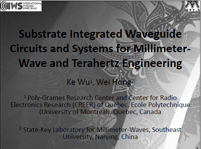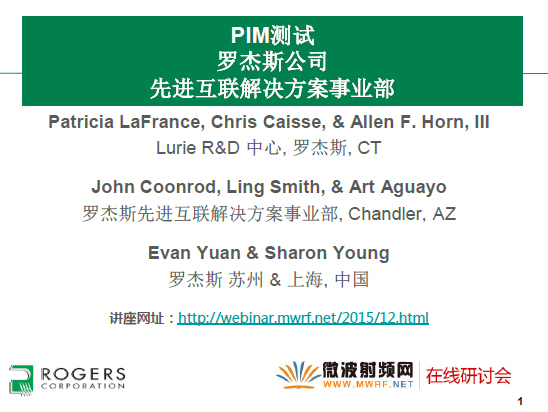| 资料语言: | 英文 |
| 资料类别: | PDF文档 |
| 文件大小: | 7.27MB |
| 浏览次数: | 0 |
| 所需积分: | 0 点 |
| 评论等级: | |
| 更新时间: | 2013-04-19 15:36:36 |
| 上传用户: | millie |
| 下载地址: |

WS7: THz Packaging Integration Technologies
Type: Half Day
Day/Date/Time: Thursday, 18 April 2013, 0830-1230
Location: Room 308
Organizers:
Dr. Morgan Chen, Huawei Technologies
Prof. Milton Feng, University of Illinois, Urbana-Champaign
Abstract:
THz frequencies have been used for decades for imaging and high-resolution spectroscopy. In order for THz technology to mature, packaging integration advances need to occur to achieve lower costs, smaller footprints, and higher functionality. This workshop will describe the latest research results on THz packaging integration. Topics include design of THz substrate integrated waveguides, THz resonators and antennas based on carbon nanotube, development of a 280 GHz CMOS 4x4 phased-array with on-chip radiators, and silicon micromachining for THz horn and lens antenna architectures.
Speaker List:
1、Prof. Ke Wu, Ecole Polytechnique de Montreal, and Prof. Wei Hong, Southeast University - Design of Substrate Integrated Waveguides for mmW and THz
2、Prof. Lin-Sheng Wu, Shanghai Jiao Tong University - Carbon-nano-based antenna and resonator for THz application
3、Dr. Kaushik Sengupta, Princeton University - Fully integrated THz circuits and Systems in Silicon
4、Prof. Goutam Chattopadhyay, Jet Propulsion Laboratory - Silicon Micromachined Integrated Array Instruments at Terahertz Frequencies
Preliminary detailed speaker abstracts and biographies follow.
1、Prof. Ke Wu, Ecole Polytechnique de Montreal, Canada and Prof. Wei Hong, Southeast University - Design of Substrate Integrated Waveguides for mmW and THz
Abstract:
This work presents an overview of substrate integration technologies in the context of substrate integrated circuits (SICs), which cover a wide range of integrated waveguide solutions for millimeter-wave and terahertz applications. Hybrid and monolithic structures are examined and discussed with emphasis on their processing techniques such as conventional PCB, LTCC, Fodel and CMOS among others for various design and development platforms. Seamless integration of antennas, arrays, and circuits are showcased to demonstrate the advantages of the emerging substrate integration technologies with state-of-the-art experimental and theoretical results. The current rapid development of passive integrated structures towards their maturity suggests the urgent search for active and nonlinear waveguide techniques that should be disruptive in view of the current voltage- and current-defined diodes and transistors. Advanced low-loss material techniques are required to cope with any further development of SICs for millimeter-wave and terahertz applications.
Dr. Ke Wu is Canada Research Chair Professor in RF and millimeter-wave engineering at Ecole Polytechnique (University of Montreal). He has been Director of Poly-Grames Research Center and Founding Director of Center for Radiofrequency Electronics Research (CREER) of Quebec. He has authored over 850 referred papers, and also books/book chapters and patents. He has held key positions in and has served on various panels and international committees including the chair of many committees and international conferences/symposia including the Chair of IMS2012. He has served on the editorial/review boards of many journals, transactions and letters including associate editor, editor and guest editor. He is an elected IEEE MTT-S AdCom member for 2006-2015 and served as chair of the IEEE MTT-S Member and Geographic Activities (MGA) Committee. He was the recipient of many awards and prizes. He is Fellow of the IEEE, Fellow of the Canadian Academy of Engineering and Fellow of the Royal Society of Canada. He was a MTT-S Distinguished Microwave Lecturer.
2、Lin-Sheng Wu, Shanghai Jiao Tong University - Carbon-nano-based antenna and resonator for THz application
Abstract:
Carbon nanomaterials, including carbon nanotube (CNT) and graphene, are expected to play important roles in future THz applications, according to their excellent electrical properties. This presentation will focus on several kinds of carbon-nano-based components. Firstly, the multiwalled-CNT-based resonator is modeled, which possesses high Q-factor and miniaturize size within THz range, due to the low resistance and high inductance of conducting CNTs. The carbon-nanomaterials are also suitable for THz antenna applications. A THz dipole antenna is proposed with a single-walled CNT bundle for nano-scale wireless interconnects. Its radiation pattern and efficiency are numerically investigated. Then, a graphene-based high impedance surface (HIS) is designed for THz regime, which is switchable according to the voltage-controllable surface conductivity of single-layer graphene. Further, a beam reconfigurable antenna can be achieved with the proposed graphene-based HIS.
Dr. Lin-Sheng Wu was born in 1981. He received the B.S. degree in electronic and information engineering, M.S. and Ph.D. degrees in electromagnetic fields and microwave technologies from Shanghai Jiao Tong University (SJTU), Shanghai, China, in 2003, 2006 and 2010, respectively.
From August to November 2010, he was a Research Fellow with the Department of Electrical and Computer Engineering, National University of Singapore. From February 2010 to January 2012, he was a post doctor in SJTU. He is currently working as a Lecturer with the Key Laboratory of Ministry of Education of Design and Electromagnetic Compatibility of High Speed Electronic Systems in SJTU, where his present research interest is mainly focused on novel techniques for microwave integration, passive components and carbon nanoelectronics. He is the author and coauthor of more than 50 technical papers.
Dr. Wu was a session co-chair of Asia-Pacific Microwave Conference (APMC) and IEEE Electrical Design of Advanced Packaging and Systems Symposium (EDAPS) in 2011. He is a reviewer of several international journals, including three IEEE Transactions and Letters.
3、Dr. Kaushik Sengupta, California Institute of Technology - Fully integrated THz circuits and Systems in Silicon
Abstract:
THz technology has, so far, been exclusively limited to the realms of photonics (using femtosecond and quantum cascade lasers) and compound III-V semiconductor processes, where the technology is difficult to scale, expensive for large scale production, and often requiring cryogenic cooling. In this talk, we will discuss how silicon technology, with its high-level of integration, can be pushed into the THz frequency range, allowing fully integrated silicon THz chipsets for a diverse set of applications.
In order to overcome the limitations of lower cut-off frequencies, lower mobility of electrons and lossy substrates and passives in silicon technology, we break away from the traditional block-by-block/model-based design approach and propose novel ways of combining circuit and electromagnetic techniques in a holistic design approach. We will demonstrate the principle in the concept of Distributed Active Radiation (DAR), which enabled the first integrated, digitally programmed 4x4 phased-array with on-chip radiators in CMOS, with near 10dBm EIRP at 280 GHz, and 80 degrees of beam-scanning in 2D space.
Kaushik Sengupta received the B.Tech. and M.Tech. degrees in electronics and electrical communication engineering, from the Indian Institute of Technology, Kharagpur, India, in 2007 and the PhD degree in electrical engineering from California Institute of Technology, Pasadena in 2012. He is currently a post-doctoral scholar at Caltech and will join the faculty in the department of electrical engineering at Princeton University in February 2013.
During his undergraduate studies, he was invited for summer research at USC and MIT. His research interests are in the areas of THz sensing and imaging, optics, electromagnetics, stochastics and novel EM and circuit designs for biomedical and clinical applications. Dr. Sengupta was awarded the IBM PhD fellowship for 2011-12, IEEE Microwave Theory and Techniques Graduate fellowship and Analog Devices Outstanding student designer award in 2011. He is also the recipient of the Prime Minister Gold Medal Award in 2007 from IIT, and the IEEE Microwave Theory and Techniques Undergraduate Fellowship in 2006. He also received the Caltech Institute Fellowship and most Innovative Student Project Award in 2007, from the Indian National Academy of Engineering.
4、Prof. Goutam Chattopadhyay, California Institute of Technology - Silicon Micromachined Integrated Array Instruments at Terahertz Frequencies
Abstract:
Sensitive heterodyne instruments at terahertz frequencies have been the workhorse for efficient mapping, imaging, and high resolution spectroscopy over the last several decades. For important astrophysical target areas as well as for terahertz security imaging applications, large focal plane arrays of sensitive heterodyne detectors are the ideal tool. Unfortunately, the majority of the heterodyne instruments at these frequencies have been single-pixel. To develop multi-pixel terahertz heterodyne arrays for astrophysics and planetary spectroscopy as well as video rate imaging applications on mobile platforms for homeland security applications, it is essential to reduce the mass, power and volume of existing single pixel heterodyne receivers and design multi-pixel heterodyne arrays.
Conventional approach of building single-pixel receivers and stacking them to assemble multi-pixel array receivers is not suited at terahertz frequencies. What one needs are novel ultra-compact receiver architectures which are easy to fabricate, preferably by lithographic techniques, to build multi-pixel heterodyne array receivers where majority of the front-end components along with the antenna element can be integrated in a small form factor. In this workshop presentation we’ll talk about different multi-pixel receiver architectures at terahertz frequencies, specifically focusing on silicon micro-machined front-end components. We’ll discuss novel stacking of micro-machined silicon wafers which allows for the 3-dimensional integration of various terahertz receiver components in extremely small packages which easily leads to the development of 2-dimensioanl multi-pixel receiver front-ends in the terahertz frequency range.
Integrating antennas with terahertz front-end elements has been challenging as most of the planar antennas are too lossy at these frequencies. In this presentation we’ll explore novel horn and lens antenna architectures which are suitable for integration with silicon micromachined heterodyne detectors. It will be shown that using advanced semiconductor nanofabrication techniques it is possible to design, fabricate, and demonstrate a super-compact, low-mass, and highly integrated multi-pixel terahertz array receiver.
The research described herein was carried out at the Jet Propulsion Laboratory, California Institute of Technology, Pasadena, California, USA, under contract with National Aeronautics and Space Administration.
Goutam Chattopadhyay is a Principal Engineer/Scientist at the NASA’s Jet Propulsion Laboratory, California Institute of Technology, and a Visiting Professor at the Division of Physics, Mathematics, and Astronomy at the California Institute of Technology, Pasadena, USA. He received the B.E. degree in electronics and telecommunication engineering from the Bengal Engineering College, Calcutta University, Calcutta, India, in 1987, the M.S. degree in electrical engineering from the University of Virginia, Charlottesville, in 1994, and the Ph.D. degree in electrical engineering from the California Institute of Technology (Caltech), Pasadena, in 1999. From 1987 until 1992, he was a Design Engineer with the Tata Institute of Fundamental Research (TIFR), Pune, India.
His research interests include microwave, millimeter-, and submillimeter- wave heterodyne and direct detector receivers, frequency sources and mixers in the terahertz region, antennas, SIS mixer technology, direct detector bolometer instruments; InP HEMT amplifiers, mixers, and multipliers; high frequency radars, and applications of nanotechnology at terahertz frequencies. He has more than 150 publications in international journals and conferences and holds several patents. Among various awards and honors, he was the recipient of the Best Undergraduate Student Award from the University of Calcutta in 1987, the Jawaharlal Nehru Fellowship Award from the Government of India in 1992, and the IEEE MTT-S Graduate Fellowship Award in 1997. He also received more than 25 NASA technical achievement and new technology invention awards. He is a Fellow of IEEE.
温馨提示:如果您在下载过程中遇到任何问题,可以通过QQ技术群联系我们。





 粤公网安备 44030902003195号
粤公网安备 44030902003195号